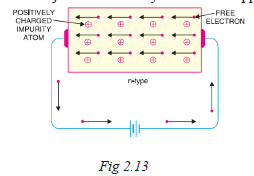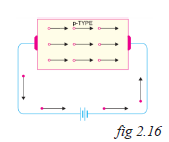Study resources on Kenyaplex
Get ready-made curriculum aligned revision materials
Exam papers, notes, holiday assignments and topical questions –
all aligned to the Kenyan curriculum.

1. N-type conductivity- The current conduction in an n-type semiconductor is predominantly by free electrons i.e. negative charges and is called n-type or electron type conductivity. To understand n-type conductivity, refer to Fig. 2.13. When p.d. is applied across the n-type semiconductor, the free electrons (donated by impurity) in the crystal will be directed towards the positive terminal, constituting electric current. As the current flow through the crystal is by free electrons which are carriers of negative charge, therefore, this type of conductivity is called negative or n-type conductivity. It may be noted that conduction is just as in ordinary metals like copper.
 2. P-type conductivity
2. P-type conductivity- The current conduction in p-type semiconductor is predominantly by holes i.e. positive charges and is called p-type or hole-type conductivity. To understand p-type conductivity, refer to Fig. 2.16. When p.d. is applied to the p-type semiconductor, the holes (donated by the impurity) are shifted from one covalent bond to another. As the holes are positively charged, therefore, they are directed towards the negative terminal, constituting what is known as hole current. It may be noted that in p-type conductivity, the valence electrons move from one covalent bond to another unlike the n-type where current conduction is by free electrons.

Wilfykil answered the question on
August 14, 2019 at 05:14
Exams With Marking Schemes
Related Questions